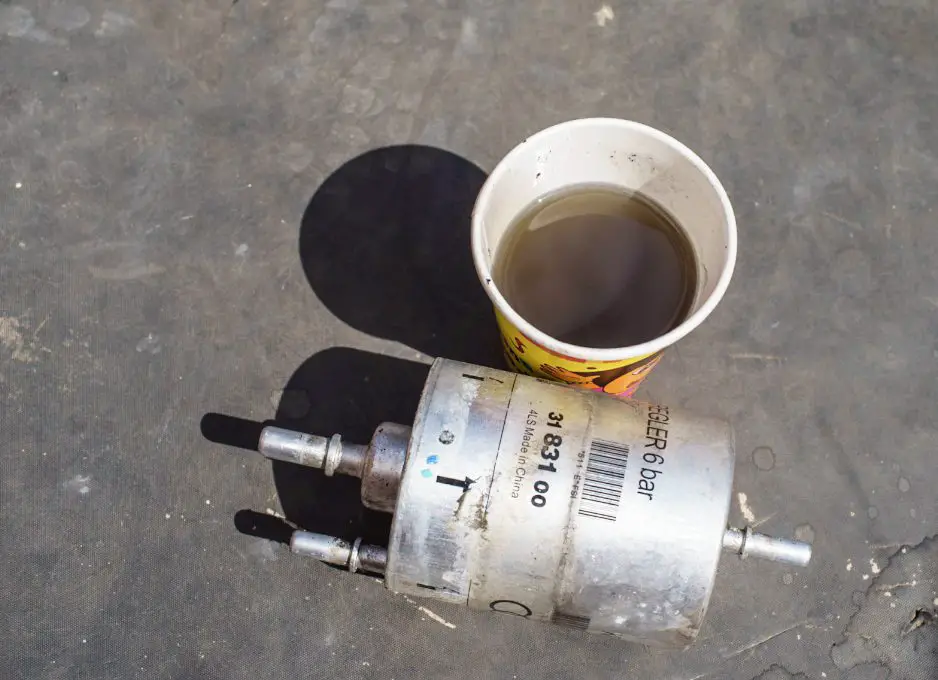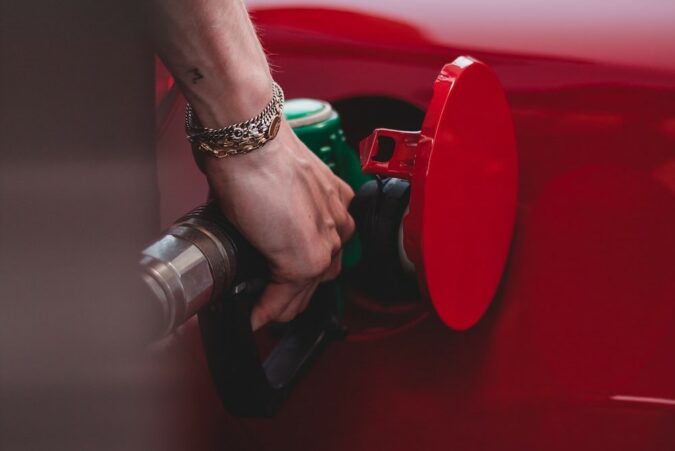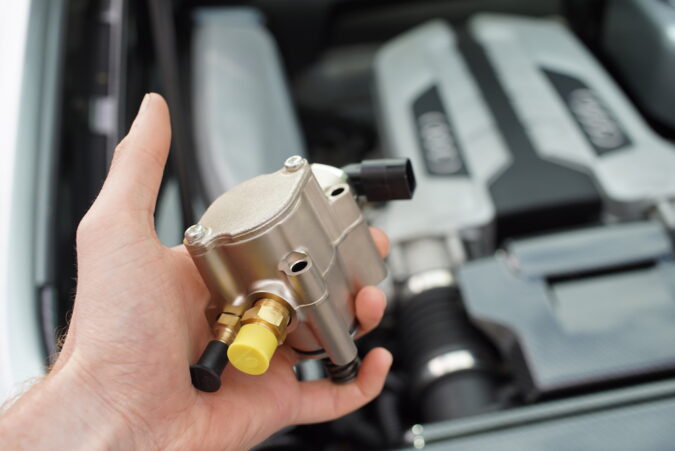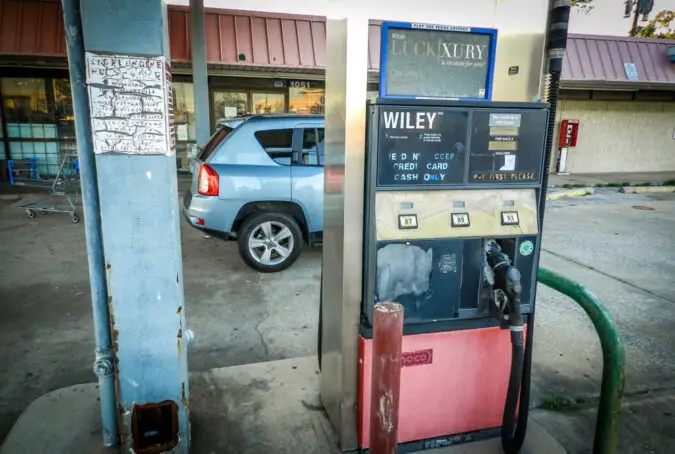So, are you feeling that your engine is running weirdly? Like it does not have enough fuel in the gas tank and you say to yourself, hmm I just filled up my tank what is wrong with my car? This can be some of the bad fuel filter symptoms.
- What Is A Fuel Filter?
- Types Of Fuel Filters
- Symptoms Of A Bad Filter
- How Much Does It Cost To Replace?
- Changing The Fuel Filter DIY
- Final Conclusion
- FAQs
There can be plenty of reasons why your car may run unevenly and stall. But the first thing you need to do is to check out the fuel filter.
A bad fuel filter symptom can be many. In this article, we are going to discuss these symptoms and learn more about why these filters are clogging up and causing you a major headache in the process.
The bad fuel filter symptoms are very obvious. If you are into cars, you will probably notice them right away. And like with every expendable part on our cars, so the fuel filters tend to fail at some point.
Keeping regular maintenance is important to avoid these issues. Because if you replace everything on time, you will not come to deal with these issues.
But also, there are some reasons for this. For example, you just bought the car and you don’t know what has been changed on it and you are clueless. But don’t worry, that’s why we are here.
We will explain to you what are the bad fuel filter symptoms. And also, how you can take care of this issue by using DIY methods. So, if you are interested and want to learn more, follow along.
Fuel Filter
The fuel filter is a device that is installed on your car. This device has a role to filtrate the fuel from dirt particles. These filters are designed to trap microscopic particles of rust, dirt, and other impurities that come inside the gas.
Refineries refine the oil, but they can’t do it 100% perfectly, there is still some dirt left inside the gas. This may be not visible to the naked eye. But the filters will prevent these microscopic particles from reaching your engine.
This level of filtration is needed because modern fuel systems are rated between 10 and 30 microns. This is microscopic level, and the tolerances are super tight. So, if you do not want to damage your fuel injection system by injecting bad fuel, you need a fuel filter on your car.
The fuel passes through the filter and delivers clean fuel all the time. If the fuel gets clogged with particles, it will cause the engine to stall and cause poor performance. These symptoms mean that it’s time to change the filter. Swapping the filter as soon as possible will make your engine run smoothly. It will also deliver a good performance.
Types Of Fuel Filters
There are a couple of types of fuel filters, depending on the location they are at. The fuel filter is usually located somewhere between the gas tank and the engine. These are called inline filters; they are attached to the fuel line and the fuel passes through them. The name itself tells a lot about their location.
Some filters are inserted inside the fuel tanks. These vehicles usually are running on returnless fuel systems.
There are also a few types of connections that fuel filters use. Most filters are push-on, which means that they feature small protruding tubes that go in the fuel hoses and are secured by clamps on both sides. These are the most common.
Other types of filters use threaded connections. These are rarely used but are still available in some vehicles.
Fuel Filter Location
The location of the fuel filter may vary depending on the make and model. They are usually under the car where the fuel lines go. You can easily spot them with their cylindrical form. You can see how two lines are attached to them.
Some carmakers are installing these filters in the front of their vehicle. Namely in the engine bay. This is one of the most obvious places to locate your filter if you cannot find it under the vehicle. You can see it attached to the firewall.
In some muscle car applications, these filters are see-through and you can visibly distinguish them and replace them. They are usually somewhere in front of the engine near the carburetor. You will spot them with their see-through design and will notice the fuel inside them. They should be yellow in color.
Clogged Fuel Filter Symptoms
A bad fuel filter may be caused by a series of symptoms. When the fuel filter is bad, the engine does not get enough fuel inside and this causes a lot of issues. These issues can also mean a lot more things, so when investigating a problem, it’s best to focus on the problem. Because troubleshooting asks for thinking and making the right solutions. You need to connect the things in your head and find the real issue.
Now we are going to discuss one of the most common symptoms connected to these filters. Later we will see what are the proper fixes for these issues. It should be noted that these symptoms may also occur when you have a failing fuel pump as well.
Bad Fuel Filter Symptoms #1: Problem With Starting
If you have a bad fuel filter one of the first symptoms you will notice is a rough start or not starting at all. This can be a problem that is frustrating to have because you need the car right away. You may first think that you don’t have enough fuel, but that’s not probably the reason. Especially if you filled up the tank the day before.
One of the biggest reasons why your car cranks but cannot get enough fuel pumping into the engine is a bad fuel filter. After a few cranks, it may pull some fuel inside and start cranking but don’t hope that it’s going to last for a long time. Because it may soon stop sending fuel and the car will shut down in the middle of the traffic. And trust me, you don’t want to get stranded in the middle of nowhere.
This problem is very similar to a bad fuel pump, but you should not connect these two issues. You can check your fuel pump by putting your key into the ignition. If you hear a clicking sound at the back, it means that the pump has engaged and is ready to work. So, that means that the fuel filter is one of the few probabilities because your car won’t start.
Bad Fuel Filter Symptoms #2: Rough Idle
Rough idle is one of the bad fuel filter symptoms as well. Especially if your car sounds like an old man trying to get fresh air. You can notice this by starting your car and observing the tachometer.
Check out the gauge and see how the needle works. If it starts shaking, it means that it cannot hold the right RPM. Usually, when you start your car, the needle goes at 1000 RPM and then drops to around 800 RPM.
If when you start the engine, the needle goes above 1000 RPM and shakes a lot it means that its something wrong with the fuel filter. When the engine warms up and drops to 800 RPM and keeps dropping and even shuts down. This is a clear giveaway that you have a bad fuel filter.
Cars usually shut down because of bad sparks or not enough fuel. If you have a bad spark, you should look at the coils and spark plugs. If you think it’s a fuel issue then the fuel filter, injectors, and fuel pump will be the first thing to check.
We explained above how you can check if your fuel pump is bad. If you don’t hear a clicking sound when you insert the key, it means that its something wrong with it. If not, it’s the fuel filter.
Bad Fuel Filter Symptoms #3: Poor Acceleration
Bad acceleration can be a clear giveaway if you have fuel system-related issues. Usually, when your car accelerates slowly, it can be three things. Bad spark, bad fuel injectors, bad fuel filter, and bad fuel pump. You should narrow down your list and try to troubleshoot what could be the possible culprit.
For example, if you have a bad spark. It is a good idea to replace your spark plugs and wires. They go bad after many miles of service and should be serviced quite often. You should change them at around 50,000 miles.
If not, it could be hard to start your car and keep it moving. If there is no spark it means that the fuel is not ignited and the cylinders are getting soaked in fuel. This may cause friction and eat up your cylinder walls.
If you have a check engine light on the dash. It is a smart idea to get an OBD scanner and scan the car for issues. There may be a few of them. Search these codes online and learn more about them. The codes are going to tell you a lot about your car. Especially if you have bad coils or a bad fuel pump.
Unfortunately, the fuel filter is not connected to the computer and you can’t diagnose the bad fuel filter issue with the scanner. So, if nothing appears on the scanner and your car still runs rough and doesn’t accelerate, could be the fuel filter. Replace it and see the results. If things get fixed then great, if not you should look for your problem elsewhere.
Bad Fuel Filter Symptoms #4: Big Drop In Fuel Efficiency
Although it sounds logical to think that when the fuel gets obstructed to enter the engine the fuel economy should improve. But unfortunately, that isn’t the case. Namely because if you have an obstructing filter, the engine ECU will start to demand more fuel be sucked into the engine.
More fuel equals more fuel spent. This will result in terrible fuel economy. Your engine will run poorly and spend a lot of fuel in the process to keep up running. Your RPM will jump all of a sudden with no particular reason, and then drop, and then jump again. This is a clear example of how increased fuel consumption happens when you have bad fuel filter symptoms.
Bad Fuel Filter Symptoms #5: Engine Stalling
If the lifespan of your fuel filter is coming to an end. The engine stalling issue will be a regular occurrence for you while you drive. You will notice this instantly. The first sign will be when the engine RPM will drop while idling.
You will need to apply your foot on the gas in order to deliver more fuel to the engine. But that won’t be enough in this case. Even if you apply enough pressure on the gas, the engine may still stall if the fuel passage is blocked 100%.
This may happen to you quite often and your car could possibly die while waiting at the traffic light.
Bad Fuel Filter Symptoms #6: Engine Misfiring
Engine misfires may also occur, not that often like the other symptoms but they are known to happen. If your engine misfires, you will notice it by the uneven work of the engine and the check engine light that usually appears when the engine is misfiring.
Bad Fuel Filter Symptoms #7: Check Engine Light
A check engine light may also appear if you are having a clogged fuel filter. But it will not appear by the fuel filter itself. Because the fuel filter is not connected to the car electronics and its service is not observed by the car computer.
The check engine light usually appears if there are any other problems. For example, if your engine runs unevenly as we mentioned before, you could get errors from the sensors. Like the mass airflow sensor (MAF) that measures the air sucked into the engine.
Running your car like this with a clogged-up fuel filter can cause all sorts of issues and you don’t want that. Every electronic in your fuel system will get confused and will start popping up errors all the time.
And then things may get expensive. Because mechanics replace the faulty components, and if your sensors are not faulty and simply show errors because of your fuel filter. You will end up with a huge bill at the end.
To avoid this, replace your fuel filter regularly. You will be free from issues and your car will run great.
How Long Can You Drive With A Clogged Fuel Filter
Running your car like this is not recommended, as we mentioned above, your sensors may get confused and they can cause all sorts of issues. And you also don’t want to run the car like this because of the poor performance. Imagine that you are in traffic and you need to pass someone immediately, but you can’t because you are down on power. This may involve you in an accident.
Or another example is if you are driving in the middle of nowhere when there is no traffic at all and your car suddenly shuts off by itself. This is one of the worst-case scenarios that you want to avoid. Being stranded somewhere where there is no one could be a bad idea. The nearest help that you could get can be hours away from you.
Fuel Pump Damage
Running your car like this can also lead to premature fuel pump failure. If you run your car like this for a long time, it can put a lot of stress on the pump. This is because the fuel pump gets instructions from the computer to pump some fuel into your engine.
When the pump does this, the fuel needs to pass into the fuel filter. And if the fuel filter is blocked, it means that it stops the fuel in the middle of its travel. Your fuel pump continues to engage unsuccessfully and this causes big stress on the pump.
If you run your car like this. The fuel pump will eventually malfunction and will not engage when you put your key in the ignition. Then you will need to get a new fuel pump as well. Make sure you know how much is a fuel pump and the fuel pump price and where to get a fuel pump replacement near me.
These fuel pumps can cost from $200 and up, depending on the vehicle you have. Some pumps in high-performance applications tend to be a lot more expensive than those found in regular cars.
Fuel Filter Replacement Cost
Fuel filters are cheap. You can find them anywhere between $15 and $60. They are readily available at any well-equipped parts store across the US. Remember to always get a good fuel filter. You don’t want to get a cheap one that will allow dirt particles to enter your engine and possibly ruin your injectors.
But this is only for the cost of the parts. The labor on the other hand is quite expensive. Replacing these filters at a mechanics shop is going to cost you between $100 and $300.
Depending much on the vehicle you have and the level of specialization of the mechanic’s shop you go to. Because some places are cheaper and some places tend to get more expensive.
If you want you can do it by yourself, first look online for bad fuel filter symptoms. Then get a new filter and get your hands dirty. We are going to explain later on how you can do this in a couple of easy steps.
How Often To Change Fuel Filter
Fuel filters are usually lasting for around 30,000 miles. Although it is recommended to replace them before this. Change them after 25,000 miles to be on the safe side. If you don’t want to get in trouble and your car not to start all of a sudden.
Also, get a notebook and keep it in your garage. Take notes on every change you made on your car and with what mileage. This will help you a lot in terms of keeping the car regularly maintained. And if you want to decide to sell this car, if you show the notebook to a protentional buyer, it’s going to be easier to sell the vehicle.
People feel more secure when they are dealing with people that regularly maintain their cars. Personally, I wouldn’t buy a car from a guy that has not maintained the car correctly, because how should I know what has been changed on it and on what mileage?
How To Change Fuel Filter
Changing your fuel filter is not an easy task, although it may seem simple there are a few steps that you need to follow in order to do this job the correct way. We will go through all the steps needed to make this service all by yourself.
Step 1
Get an OEM replacement part for your car, this is important because you don’t want to install cheap filters that will possibly damage your injectors.
Step 2
Disconnect the positive terminal of your battery, this will make sure that your fuel system is depressurized and your fuel pump is not engaged.
Step 3
Place a drain pan under the fuel filter if something goes wrong, you don’t want gas spillage on your driveway.
Step 4
Loosen up your fuel filter clams and disconnect the fuel line fittings.
Step 5
Replace the old fuel filter with a brand-new one. Remove the bolts that hold the filter if any, and then bolt the new filter in the same position.
Step 6
Reattach the fittings and take a screwdriver to apply pressure on the clamps. Get them real tight in order for the fuel not to leak.
Step 7
Reattach the battery terminal and put the key in the ignition, and wait for the car to start the fuel pump. Once there is pressure in the fuel system, start the car.
Step 8
Look under the car if there are any fuel leaks. This is important because you don’t want fuel to leak and cause hazardous situations. If everything is ok, you are good to go.
Bad Fuel Filter Symptoms: In Conclusion…
In this article, we discussed the bad fuel filter symptoms thoroughly and learned a lot about what a bad fuel filter may look like. As we mentioned above, if your fuel filter is bad then you are probably going to lose power.
Rough idle is also one of the issues that happen when the fuel filter is bad, stalling also occurs more rarely. Stalling usually happens in the most extreme cases when the fuel filter was never replaced.
If you always want to be on the safe side, service your fuel filter regularly. Replace it every 30,000 miles and you will never have an issue with it. And your car will run perfectly smoothly.
FAQs On Bad Fuel Filter Symptoms
If you’re still curious to learn more about bad fuel filter symptoms, our FAQs here might help…
Where Is The Fuel Filter Located
In most cars, there are one of two places where a fuel filter could be found. It might be located within the fuel tank itself, often placed in the opening of the fuel line, as fuel exits the gas tank and is circulated to the engine. Or, the fuel filter might also be located as part of the fuel line. The fuel line is what runs fuel from the tank to a car’s engine, through a series of tubes and hoses underneath your car. From either of these two locations, the fuel filter can effectively filter out impurities, dirt, as well as other contaminants within the gasoline or diesel before it reaches the engine. Thus, ensuring that the combustion process can take place properly and smoothly.
How Much For A Fuel Filter
Relative to most other car-related repairs or maintenance work, replacing the fuel filter is comparatively cheap. The fuel filter itself can be had for as little as $15 to $60. Meanwhile, a mechanic won’t often charge too much for labor. Thus, bringing the total (parts and labor included) to anywhere from $100 to $300, for most vehicles, on average. A key factor that will determine the final tally, however, will be the accessibility of the fuel filter itself. With some cars, the fuel filters are notoriously hard to access or service. Therefore, a typical mechanic will have to spend more time (i.e. labor hours) and effort in needing to replace it, which will drive up the labor fees.
How To Clean Fuel Filter
If your car’s fuel filter is clogged up, it’s possible to have it cleaned, instead of needing to opt for a costlier replacement. Once you have the filter removed and drained of any remaining gasoline or diesel, you can use off-the-shelf carburetor cleaner to spray onto the filter. That should be more than enough to dislodge any stubborn debris that’s clogged up the filter. Although, the filter might still have some debris stuck elsewhere inside of it. You can gently tap on the filter to shake out any loose debris. Repeat it again and again – spraying the carburetor cleaner and tapping out any debris – until you’re confident that it’s cleaned. Then, let it air dry for at least 1 hour.
How To Fix A Clogged Fuel Filter
Sometimes, a clogged fuel filter can be fixed by cleaning it instead of needing to replace it outright. You can do this by removing the fuel filter, draining away any residual fuel, and spraying it clean with some carburetor cleaner. Then, tap any debris loose, letting it air dry, before re-installing it back onto your car. However, it’s only a good idea to clean a fuel filter if it’s made of metal (some cars have fuel filters made with a plastic housing), and it’s not too grimy, corroded, and overly clogged up. Otherwise, it’s a better long-term fix to have a clogged fuel filter simply replaced, which is also recommended given that the replacement costs aren’t too astronomically high.
What Happens When Fuel Pump Goes Out While Driving
If and when your fuel pump gives out while you’re driving, it’s most likely that it would stop sending fuel to your engine. Thus, it would result in a loss of power, followed by an engine stall, before your car then dies out and leaves you stranded. Although, the way in which a fuel pump fails can vary, and at that moment, what you’ll experience is possibly different, too. For example, a failing or faulty fuel pump might instead send too much fuel to the engine instead of too little or none at all. When that happens, the engine will surge, as you notice the engine picking up speed. Then, dropping in speed soon thereafter… Even though you’ve not touched the gas or brake pedals.




